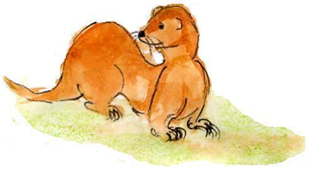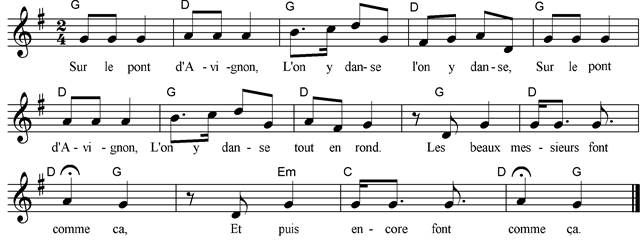 Au baguette du roi
Au baguette du roi
À la ronde des muets
En roulant ma boule
La reine à dit
Melchior et Balthazar
En train
de travailler
Au feu les pompiers
La belette
La fille du coupeur de blé
Le facteur n’est pas passé
Scions du bois
Sur le pont d’Avignon
Voulez-vous le ramoneur?
Last updated: 3/15/2016
4:12 PM
The songs below are part of ‘Allons-y!’ The French collection
compiled, adapted, translated and illustrated by Dany Rosevear
![]() To listen to music from these
songs click on O
To listen to music from these
songs click on O
To watch the
author sing a song click on the title at:
Return to the ‘Singing games for children’ home page
You are
free to copy, distribute, display and perform these works under the following
conditions:
·
you must give the original author credit
·
you may not use this work for commercial purposes
·
for any re-use or distribution, you must make clear to others the licence
terms of this work
·
any of these can be waived if you get permission from the copyright
holder
Your
fair use and other rights are no way affected by the above.
|
À la ronde des muets
O A
traditional dance that originates from the In
this game initially only the leader or ‘king’ sings. The king holds a stick
or mace. As the ‘guilty ones’ turn round they also join in with the singing
and give orders.
|
|
En roulant ma boule
O This
French Canadian canoe paddling song dates back to the 15th
century. Popular among French fur traders, this and similar songs such as ‘Allouette’ encouraged regular paddling in unison, passed
the time and made the work seem lighter. The full version of thirteen and
sometimes more verses, expresses anti royalist sentiments of the time; the
son of the king depicted as a figure of fun who shoots a young lady’s pet
duck. For
the long version listen at: http://www.youtube.com/watch?v=gf9puOwdaYg&feature=related
|
|
La reine à dit O Form
a line led by ‘la reine’ or’le
roi’. Each time a verse and its music is finished
the leader retires to the back so a new monarch is heading the line. In
the translated version add the new leader’s name to each verse.
|
|
Melchior et Balthazar O Sung
as a round in the Languedoc but here adapted as a clapping and circle game. A
song for ‘Noel’. Choose three kings to mime actions in the centre of the
circle. Watch
at: http://www.youtube.com/watch?v=N8gAO56kRw0 Encourage
children to develop their own clapping patterns.
|
|
Include
this song with a topic on ‘People who help us’ or ‘Safety in the home’.
Invite the fire service in with a fire engine if possible. Dress up in a
firefighter’s costumes and set aside a role play area outside for fire fighting. Have
different buildings burning: l’école, l’eglise etc. Vary the miscreant: C’est
mon petit frère, C’est mon souer
ainé, C’est mon oncle Jules, whoever you wish to blame! Listen
at: http://www.youtube.com/watch?v=iWyo5kcgIg0&feature=related
|
|
La belette O Here
is a French version of ‘Pop goes the weasel’. Play
this game in two, three or four sets of three. Two in each set make a circle,
the third, the weasel, stands in the middle. The little circles form a larger
one.
|
|
La fille du coupeur de blé O There
are several variations of this song and dance from Brittany. In
groups of eight make two lines of four facing each other. Hold hands with
partner opposite.
Chassé c |
|
Le facteur n’est pas passé O Has
the postman got a letter for you? Play this game in a similar way to Lucy
Locket. Watch
at: http://www.youtube.com/watch?v=Vh0eaD_d4_o
|
|
Scions du bois O A
game for strong vigorous sawing action. Find the same refrain in the needle
threading song ‘Enfilons aiguilles de bois’. Watch
at: http://www.youtube.com/watch?v=LIljwsMIb3o and
http://www.youtube.com/watch?v=KFeqzB5U_3E
|
|
Sur le pont d’Avignon O ‘Sur
le Pont’ was written by an anonymous composer in 1853. At this time dancing
occurred under rather than on the bridge The initial wooden bridge spanned
the River Rhone dividing Watch
at: http://www.youtube.com/watch?v=ya8EZ5092RU Make
a circle with boys and girls alternating.
|
|
Voulez-vous le ramoneur O The
children should be very familiar with this tune, ‘Have you seen the muffin
man?’, but in this French version it is a chimney sweep that takes centre
stage. It
is far more enjoyable and effective for young children to build up a
vocabulary of verbs by acting them out rather than by way of rote learning,
Provide the sweep with a brush or suitable clothing. Place a chair in the
centre. Children make a circle holding hands. The chimney sweep stands
outside.
|
Return to the ‘Singing
games for children’ home page






























